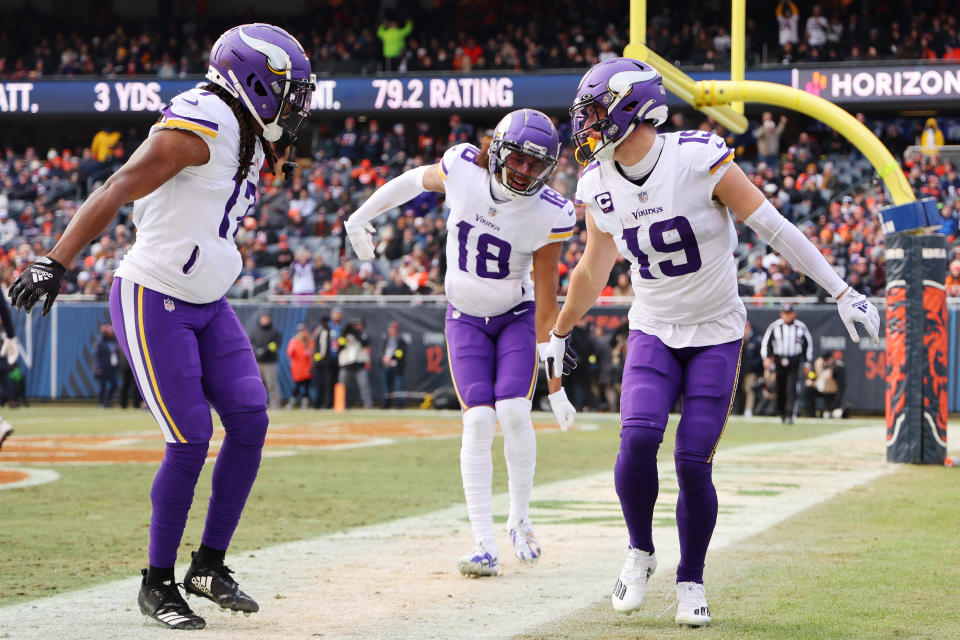The Minnesota Vikings team on the standings page doesn’t seem to connect to the team on the stats page. But as you know by now, it’s not a computer glitch. Kept more than afloat by Justin Jefferson heroics, 61-yard field goals, huge Josh Allen mistakes and a record-setting comeback against the Colts, the Vikings enter the playoffs 13-4 despite all manner of metrics showing them to be a .500-ish football team at best.
Athletes and fans understandably bristle when their team’s success is attributed to luck, but it’s time for these Vikings to lean in to their roles as all-time beneficiaries of randomness. This is not just a better-than-you’d-expect season. This is the Powerball jackpot winner of football teams.
The NFL’s most mediocre elite winners
Pick pretty much any stat beyond actual wins and losses, and the Vikings’ success starts to look perplexing. Football Outsiders’ DVOA metric for team strength rates the Vikings as the 27th-best team in the league, behind such luminaries as the Raiders and Broncos. Their defense was sixth-worst in the league by points per drive and third-worst in plain old points per game.
Perhaps most glaringly, the Vikings — who, again, won 13 games and lost only four — managed to give up three more points than they scored this season, and the margin was wider before they got that Justin Fields-less Bears team in Week 18. Logistically, you know how this works. Minnesota went 11-0 in one-score games, a situation that will almost always split down the middle over time, and suffered three blowout losses.
In a sport with so few contests per season, we tend to get a better picture of true performance by drilling down into more granular indicators. Pythagorean expected wins, which estimates a team’s record based on point differential, gave the Vikings 8.4 wins. By that measure, they are the luckiest, most random, most unreasonably successful — whatever you want to call it — team to log a .700 or better winning percentage in the Super Bowl era. Per Pro Football Reference’s calculations, the Vikings’ actual winning percentage (.765) surpassed their expected one (.494) by more than that of any other team to reach that level, which amounts to a 12-win season in the current, 17-game world. The closest contenders were the 2019 Green Bay Packers (13-3 with 9.7 expected wins) and the 2016 Oakland Raiders (12-4 with 8.7 expected wins).
This team, statistically, has more in common with borderline contenders scraping into the playoffs by the skin of their teeth, a la the Tampa Bay Buccaneers or Miami Dolphins. In the past three seasons, 11 teams with better point differentials than the Vikings missed the playoffs entirely … a group that includes the 2021 Vikings.
There’s no point trying to explain the Vikings’ season thus far, but their journey isn’t over. They are set up with the NFC’s No. 3 seed, no matter how deserving (or not) they might be. Is the Vikings’ incredible luck destined to run out? Or could it carry them all the way to the Super Bowl?


Does pixie dust carry into the playoffs?
Now, the Vikings are a historic outlier among teams that won 12 or more games, but middling teams make the playoffs pretty routinely. Since 1966, 53 teams have made it with a negative point differential. That includes four this season — the Vikings, Buccaneers, Dolphins and Minnesota’s first-round opponent, the New York Giants.
The Giants seem to have been dropped out of the sky to provide a cosmic reminder of what’s possible, if unlikely. Among those 53 teams with underwater regular-season stats, only the 2011 Giants even made it to the conference championship game. But Eli Manning’s second miracle squad went on to win the whole thing. That late-running club became the worst regular-season team to win the Super Bowl, edging out … the David Tyree’s Helmet vs. Goliath story of the 2007 Giants (point differential, +22).
To the degree we can locate historical ancestors, things don’t look promising for Minnesota. The 2012 Colts reeled off an 11-5 season despite a performance that portended only 7.2 wins, then got punted out of the playoffs by the 10-6 Ravens in the wild-card round. The 2016 Raiders — 12-4 despite an 8.7-win expected record — took a 27-14 beating from Bill O’Brien’s 9-7 Houston Texans in the playoffs.
Besides those 2011 Giants, the 2008 Arizona Cardinals are the worst team (by point differential) to reach the Super Bowl. And they might prove an aspirational model. Like the Vikings, their defense ranked 28th in the NFL in points per game. Like the Vikings, they leaned on a transcendent wide receiver (Larry Fitzgerald), but their offense graded out more highly than Minnesota’s.
The real case for hope might reside in Minnesota’s potential playoff opponents. One reason it’s so difficult to find comparisons for this Vikings team is because most teams with this sort of regular-season performance squeak into the playoffs and wind up playing a road game against a better team in the first round.
In five games against eventual playoff teams this year, Minnesota allowed 26.8 points per game and scored only 18.8 points per game — even though the Vikings managed a 3-2 record, because of course they did. That absurd record earned them the privilege of playing a Giants team fortunate to get to 9-7-1, sporting a minus-6 point differential.
The Vikings would be the second-worst team, by point differential, to make it to a conference title game, should they do so. But with a couple of breaks, they could get there without facing a team with a better underlying performance.
It’s unlikely! It would require the Seahawks to upset the 49ers and the Buccaneers to beat the Cowboys, but that would deliver Minnesota to the doorstep of the Super Bowl without requiring the Vikings to face the reality most overachievers run into immediately.
Given Minnesota’s season so far, you might not want to be too confident it won’t happen.
